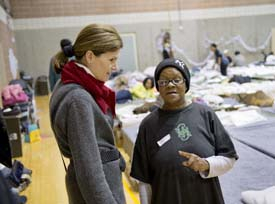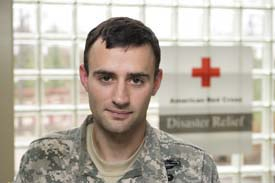More than 800 people, including 125 children, evacuated from Atlantic County in emergency shelters on campus

While Rutgers University was spared serious damage from Hurricane Sandy, the university community has been involved in ways large and small to assist in the wake of destruction left behind by this week’s historic storm.
More than 800 people evacuated from Atlantic County remain in emergency shelters set up at Rutgers’ Busch and Livingston campuses in Piscataway. Among them are several dogs and about 125 children – ranging from a set of twins about 3 months old to 18 year-olds – who are keeping busy with help from Rutgers students.
“They’re appreciative of having a place to ride the storm out and for being there with their families,” said Steven Keleman, director of Rutgers’ Office of Emergency Management. “For us, that’s the biggest thing – being able to keep families together.”
The Red Cross is providing cots, blankets, hygiene kits and hot meals for about 850 visitors, as well as medical services and counseling for those who seek it, in shelters set up at the Sonny Werblin Recreation Center on Busch and at the Livingston Recreation Center in Piscataway.
Francis Harper Barchi, the wife of Rutgers President Robert L. Barchi, toured the shelter at the Werblin gym Thursday afternoon and spoke with some of the families who had spent days at Rutgers since being evacuated. She said she was impressed but not surprised by the university’s response to the storm.
“It seemed like an automatic response to a problem,” Francis Barchi said. “My husband and I woke up and all of these things were already happening in an organized, efficient and caring way. That is the first thing that struck us.’’

She said many of the people she spoke with had high praise for everyone who had helped them at the shelter, especially Rutgers maintenance staff.
The families also told Barchi that students spent time helping them find out the extent of damage in their neighborhoods using online mapping sites.
Keleman, who has been involved with emergency management at Rutgers since 1999, said this week’s storm far exceeded the impact of Hurricane Irene last year, when the university also provided shelter for the state’s residents forced from their homes.
“For us, it’s the same challenge as Irene, but whereas Irene was severe, this was devastating. It’s a lot more emotional for the people we have here because they’re seeing images of the shore being totally destroyed. This is the most dynamic disaster I’ve seen,” Keleman said.
Diane Bonanno, executive director of recreation and community development at the university, said the students have been amazing. “We call for volunteers, and they’re here within minutes,” she said.
The students organized Halloween parties at each shelter, coming in costume and helping to distribute $1,000 worth of candy donated by Walgreens. Another group brought brownies and other goodies from a bake sale that had to be cancelled because of the storm.

“The Rutgers student volunteers saved our lives – saved my sanity, certainly. I think we've had about 60 here, and we needed them, because a lot of our own staff and volunteers couldn't get here right away because of the weather and road closures,” said Tanya Gulliver, the Red Cross volunteer managing the shelter at Rutgers’ Werblin Center.
Bonanno said she is struck by how well the shelters have been organized at every level – from the Rutgers University Police Department to the New Jersey State Police, the National Guard and even medical units shipped in from Tennessee.
“You have no idea how many agencies are here, and everyone is cooperating to the fullest to make a very uncomfortable situation comfortable,” Bonanno said. “I’ve been impressed by how considerate all of these agencies are, not only of each other, but also of us as a university.”
About 60 members of the National Guard were assisting at the shelters. They included Sergeant 1st Class Paul Greenberg. When he was a Rutgers student, Greenberg frequently went to the Werblin Center to swim in the pool. This time he was there to provide assistance. “Werblin transformed overnight from a place for hanging out to a facility designed to sustain people who have gone through hardship. It’s fantastic that Rutgers has been able to accommodate so many people in a short amount of time.”
“I live on campus, and I remembered that last year during Hurricane Irene, there were shelters at Rutgers, so I decided to come over to see if I could help,” O’Shea said. “I am a librarian, and I used to be a teacher, so I brought over supplies to do crafts with the kids – glitter and stuff like that and my Halloween costume. I was a jester. I told bad jokes.”
Yasin Baker, a seventh grader who was evacuated from Atlantic City with his mother and two sisters, served as a “shelter helper” for Bethany, running errands, escorting visitors, and helping evacuees find friends and relatives.
“I’d actually rather be in school,” Baker said, “but it's fun helping people.”
Francis Barchi hoped that the outpouring of support would continue as long as assistance is needed, even after classes and the usual pace of campus life resumes.
“With so many students, faculty and dedicated staff we should be able to have a steady stream of people helping,’’ Barchi said. “To me that is the important part. Making sure we sustain the help as long as it’s needed – I bet we can.’’